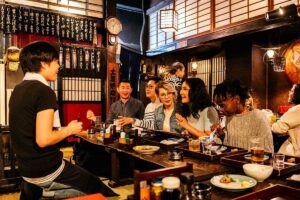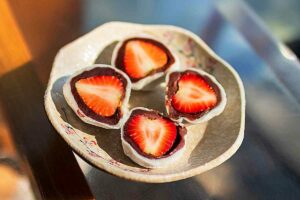If you’re a sake connoisseur, a sake set or ‘shuki’ (酒器) will upgrade your sake-drinking experience.
An exquisite sake set, complete with tokkuri (flask) and several ochoko (sake cups) not only looks impressive but is handcrafted to optimize the temperature and flavor of your sake, making that treasured bottle of Hakkaisan Tokubetsu Junmai, or Kikusui Perfect Snow taste all the better.
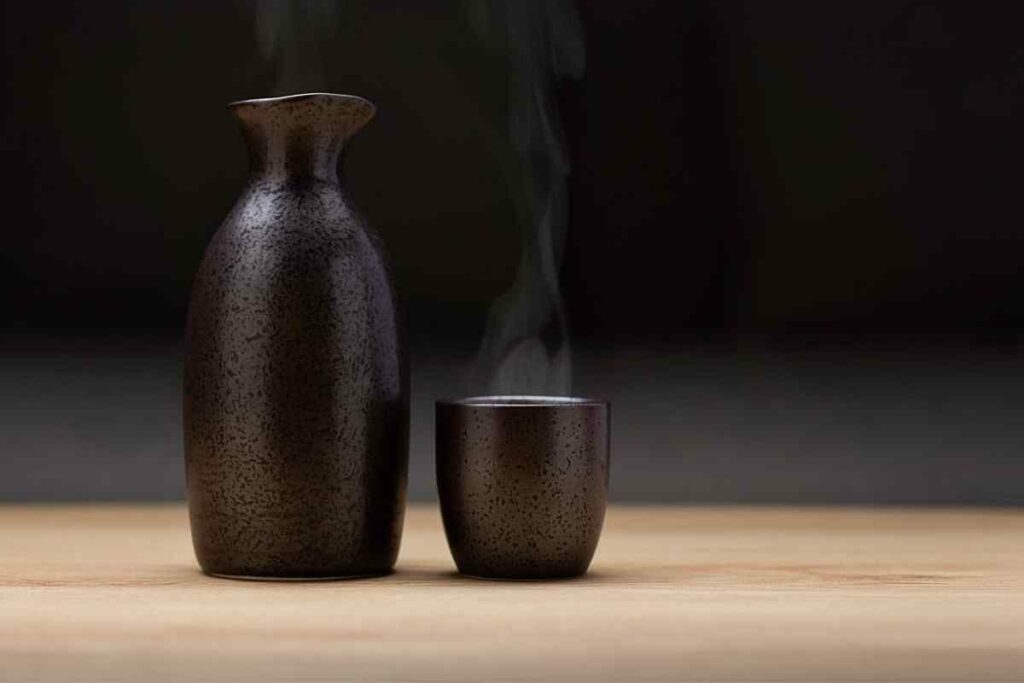
Join me as we take a look at some of the most beautiful, and unusual, sake sets on the net, including some that you can make your own.
Table of Contents
1. Custom sake set and tray
Sake sets are traditionally made from ceramic because they do not lose heat easily and can be warmed to receive warm sake.
Skilled ceramics can exercise their craft in creating completely unique designs like this delicately glazed pink and white set with gold rim.
2. Yellow on Black Sake Set
Ceramic sake sets allow artisans to experiment with a wide range of designs and detailing. Ceramists can use a variety of glazing techniques to create a stunning finish to the shuki, transforming it into something very special, a work of art!
3. Tan Tokoname Japanese Sake Set by Yamadatoen
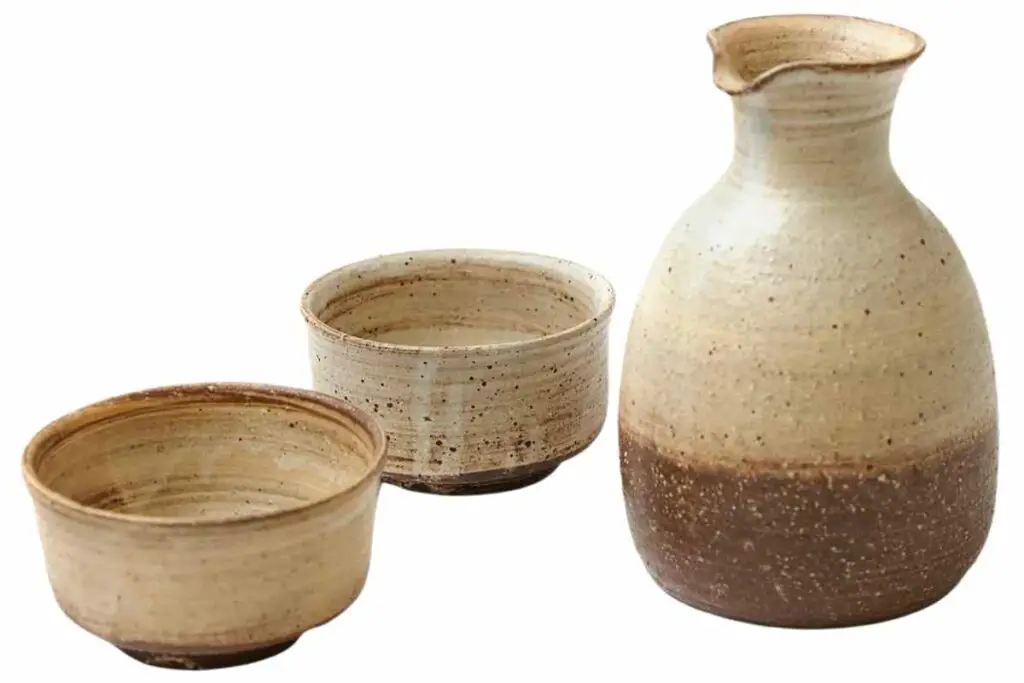
The type of clay used to create a sake set is also significant. You can buy this elegant brown and beige sake bottle set made with lightweight Tokoname clay that imparts a unique flavor to your sake.
Sake connoisseurs find that the iron in Tokoname clay softens the astringency of sake and provides a fuller flavor.
This handcrafted set by Yamadatoen Kiln includes two cups and has been fashioned using ancient techniques.
More images here
4. Wooden sake cups by Gato Mikio Shoten
Sake sets can also be made out of other materials, the most common alternatives to ceramic are wood and lacquer.
Unlike the basic traditional wooden sake box called a ‘masu’ (升), these delicate hand-turned wooden sake cups by Gato Mikio Shoten, a family woodworking house in Yamanaka, have been crafted for their aesthetics as well as function.
5. Tin sake ware
High-end sake sets are also made from tin. Sake ware made from tin is popular in Japan because of the mellow flavor it gives the sake and the ease of heating sake.
Tin is also odorless, so it does not taint your beverage. Some artisans use a tin inlay for a wooden sake cup for this reason.
6. Spring Sakura Sake Set
Glass sake sets are not uncommon either. Some people like to consider the color and condition of the sake while it is in a transparent vessel.
However, glass sake ware is not designed for warm sake. Use these sets for cold or room temperature sake.
7. Crane Kyoto Ware Japanese Sake Set by Hachiman
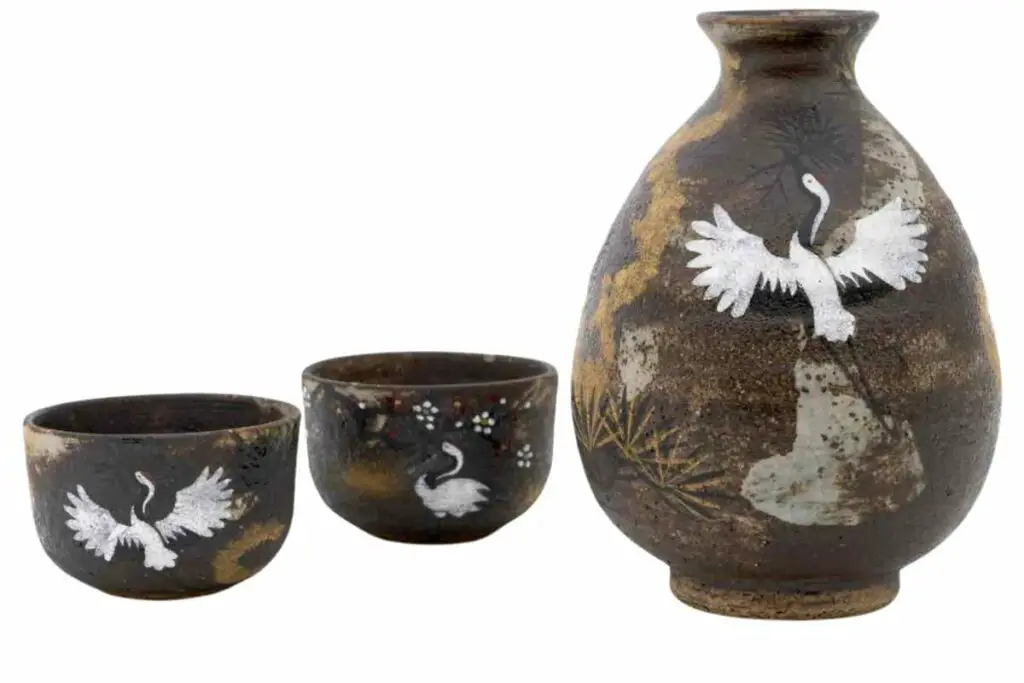
You can own this outstanding piece of Kyoto ware which includes a tokkuri and two ochocko decorated with a classic red-crowned crane for longevity and good fortune.
This sake set is presented in a paulownia wooden box, and signed by the Japanese artisan that made it.
More images here
8. Yellow spray glaze sake cups
A typical sake set includes two or four cups. Many sets are just for two, but it’s important to remember that the standard flasks only hold around 360 ml (12 oz) of sake, so it’s often better to keep the cups to two.
9. Katakuchi (lipped bowl)
A sake set may also include katakuchi. Rather than a flask, this is a spouted bowl that is used for pouring smaller quantities of sake into other vessels.
The katakuchi is also used to prepare and serve matcha (green tea), and may also be part of a matcha set.
10. Goma Bizen Ware Japanese Sake Set by Hozan
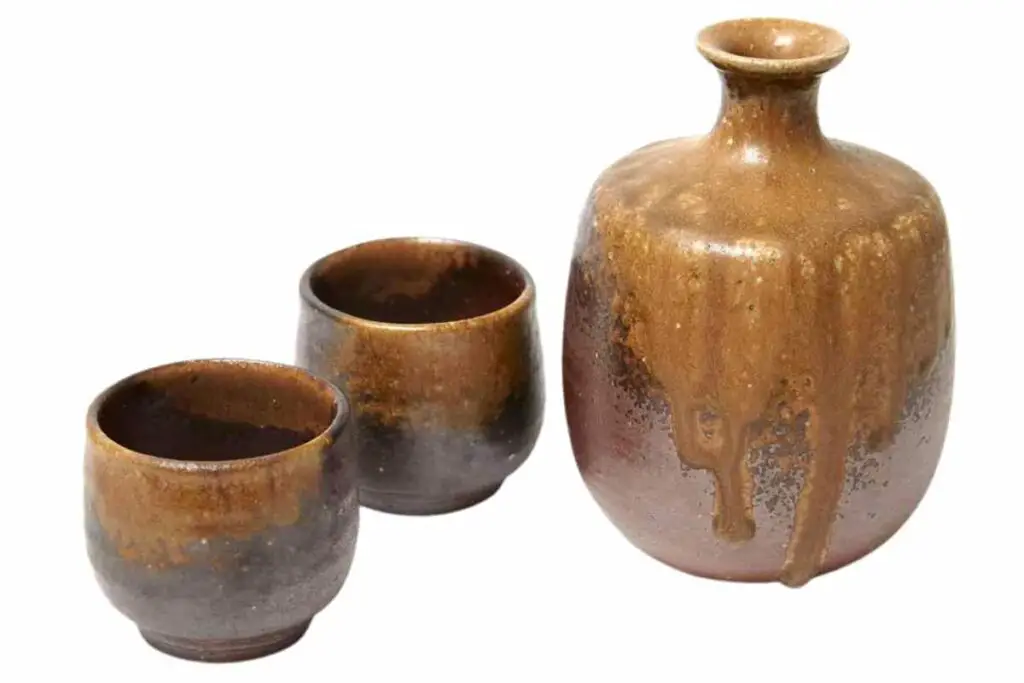
Bizen in Okayama prefecture is known for its outstanding earthenware and is considered one of Japan’s six ancient kilns.
The sake ware made in Bizen is renowned for its wabi-sabi aesthetic, with the unique imperfections in each vessel increasing in beauty and character with age.
This is the ideal sake set for an owner who appreciates the rustic natural appearance of this flask and two cups that have been fired in a traditional cave kiln.
More images here
How do you use a sake set to serve sake?
Serving sake from a sake set is completely different from drinking sake from a ‘masu’ (升) in a restaurant or izakaya.
Here’s how to serve sake using your tokkuri and ochoko:
- Pour sake into the tokkuri: Holding the tokkuri by the neck, pour fresh sake into it slowly, avoiding spills.
- Warm your sake (optional): Sake can be served warm or cold. If you want to warm your sake, immerse a filled tokkuri in warm water. Not all sake is meant to be served warm so follow the advice on the labeling of the sake or seek an expert recommendation.
- Pour the sake into the ochoko: Hold the tokkuri with one hand and the cup in the other and pour the sake into the cup until it is 60 to 70 percent full.
- When all cups are filled: Raise the cup, look at your neighbor, and give a hearty “Kanpai!” (‘dry cup’ or ’cheers!) before drinking.
- Savor your sake: Empty your ochoko in one or two sips, and savor the flavor. Refill until the tokkuri is empty.
Rounding Up
Sake is meant to be enjoyed slowly and savored and a sake set is the perfect partner for a considered and contemplative drinking experience. These gorgeous sake sets look amazing but will be even better filled with fine sake for you and your friends to enjoy.
- Bubble Tea vs Boba Compared: What’s the Difference?
- Best Izakaya Foods for a Relaxed Night Out (My Top 10 Picks)
- Edo Kiriko Whiskey Glasses (Japanese Heritage in Every Pour)
- Japanese Viral Foods on Social Media (Discover the Top 10)
- Amezaiku: 10 Amazing Examples of Japanese Candy Art
- 25 Must-Try Japanese Desserts: Old and New


